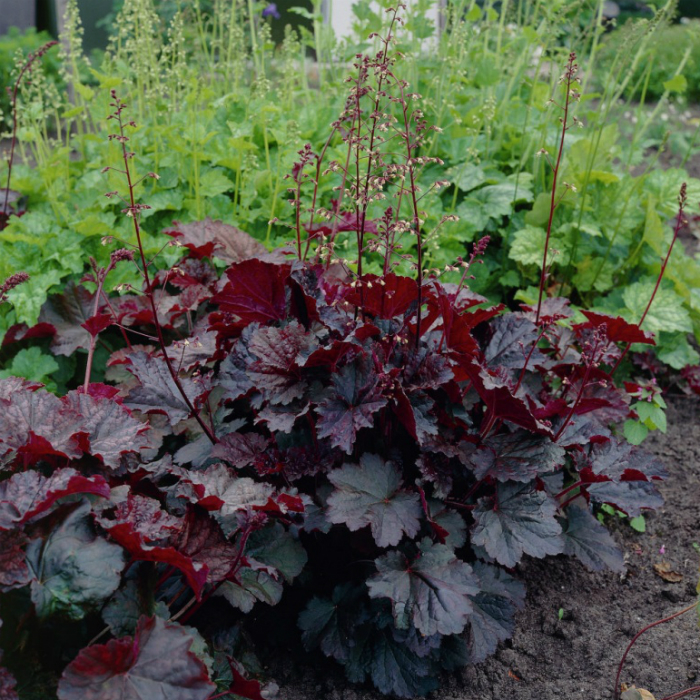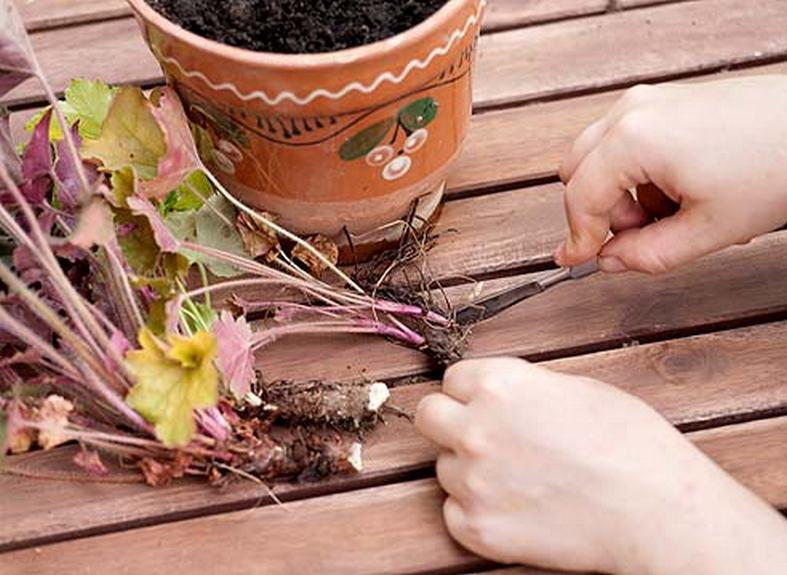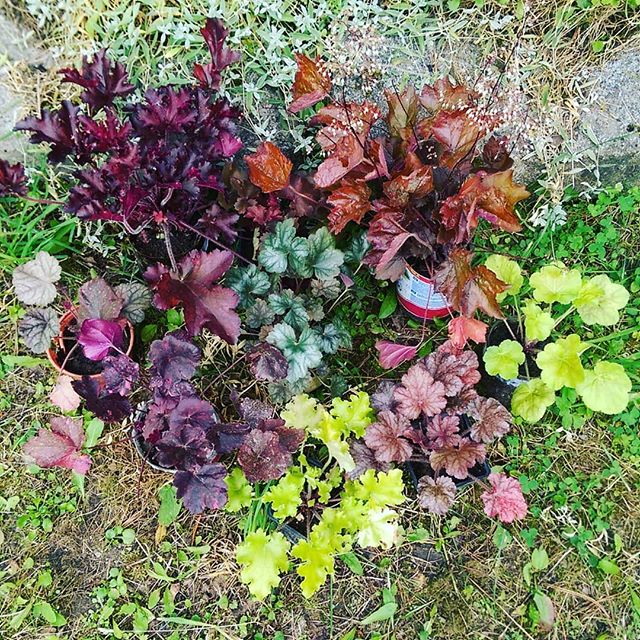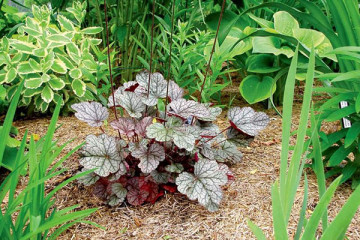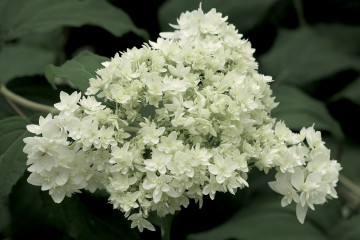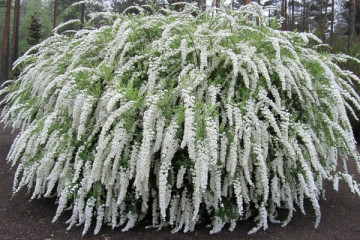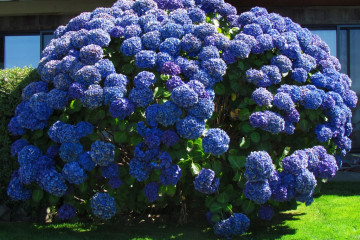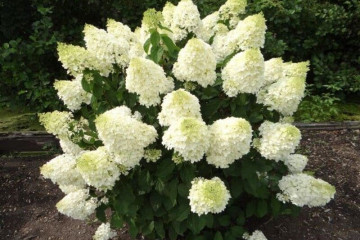Geichera Cherry Cola: description
Content:
Many landscape designers use spotted geranium as the main decorative element of the garden. A bright perennial of the Saxifrage family, the genus Rhizome is also known as the Heuchera Cherry Cola - a many-sided flower that amazes with its beauty and variegated foliage, named after the German doctor, botanist Heuchera (1677-1746). In the wild, it is found on the rocky terrain of North America.
Description of Heuchera hybrid Cherry Cola
Geykhera Cherry Cola is a bright evergreen crop with rounded cut cherry red foliage collected in a root rosette. The compact dimensions of the bush are 20 cm in height and 40 cm in diameter. Flowers appear in June and have a rare red color. Bell-shaped inflorescences are united in an oblong fluffy panicle on a peduncle 45 cm high. In winter, the plant does not shed its leaves, decorating the garden with a rich outfit.
Features of culture:
- growing in open areas, in containers and greenhouses;
- growing in the shade;
- many ways of breeding;
- harmonious addition to flower arrangements, excellent performance as a solitaire.
The main decorative value is beautiful and original foliage, diluting the monolithic background of the garden with bright colors.
Varieties of Heuchera
More than 400 varieties of Cherry Cola Heuchera have been registered, the description of most of the species has an original color of leaves that changes throughout the season. In the wild, 70 species of bushes are common. Conventionally, the culture is classified into 2 groups: forest and mountain.
Forest Heuchera is demanding on soil moisture. The maximum moisture level is maintained by mulching the crop. Stagnant water negatively affects the development of the garden plant. When planting in clayey areas, you should take care of drainage (broken bricks, gravel) and leavening agents (sand, compost).
Common varieties of the subspecies:
- American Heuchera looks like a geranium. The leaves are heart-shaped, the color palette is contrasting: purple at the bottom and green at the top. Cuttings are high, large rosettes with yellow-green panicles are placed.
- The hairy bush is characterized by the lowered shape of the peduncle and the cutting. The foliage is large, velvety to the touch.
- Cherry Cola hybrid heuchera is easily recognizable by its voluminous openwork or semicircular leaves with or without patterns. There is a wide variety of shades.
Mountain Heuchera withstands cold and drought, does not tolerate stagnant moisture in the area, ideal for rock gardens. Among the variety of varieties, gardeners make a choice in favor of:
- blood-red geykhera with rounded green-beige leaves;
- a cylindrical culture with massive foliage, decorated with a silvery pattern and coral or pink flowers, the height of the bushes is 80 cm;
- a small-flowered variety with red maple leaves decorated with silver threads and small pale pink flowers.
The colorful and extraordinary Heuchera will inevitably become a favorite of the garden, park or terrace. However, the small size of the plant requires the right approach to creating a flower arrangement. Otherwise, the flower will be lost.
Planting and caring for Heychera
Planting heuchera Cherry Cola outdoors is carried out in the spring (March-April).The shade-loving plant will take root well in the western or eastern part of the garden, receiving direct sunlight in the morning and evening.
The soil
The culture does not show any particular demands on the soil. Its natural habitat is the rocky shores of the Great Lakes. When growing a perennial at home, you should prepare a looser and more nutritious soil, which allows you to achieve maximum branching of the bush. The soil pH is 5-6.
Top dressing
After planting in the first year of growth, it is not necessary to feed the plant. Further fertilization is applied annually during the growing season. If you grow decorative leafy varieties, mineral additives are suitable for feeding, decorative flowering species are fed with universal fertilizers for flowers. Fertilize the soil twice a season, before flowering and after, using half a dose recommended by the manufacturer.
Watering
Heuchera hybrid is irrigated once every two days after the topsoil dries out. The flower tolerates drought better, relative to the stagnation of liquid in the rhizome. In hot and dry periods, the soil is moistened in the morning and evening. Water is poured under the root, preventing the foliage from getting wet, accompanied by burns.
Breeding methods
Propagated Heuchera Cherry Cola hybride by seeds, cuttings, dividing the bush. The seed method does not guarantee the preservation of varietal qualities, they prefer to propagate the plant with a leaf, cuttings or layering.
Generative method
Planting instructions are suitable for gardeners who want to get quick results at minimal cost. For seeding, shallow containers with drainage holes are suitable. A layer of expanded clay is laid at the bottom, the containers are filled with soil and covered with clean sifted sand. The soil is moistened with a spray bottle. Seeds are scattered in a chaotic form, evenly spreading over the box. The containers are covered with glass or foil, placed in a lighted place, excluding direct sunlight.
Care for the first shoots begins with airing. When the seedlings get stronger, the glass or film is removed. Seedlings dive with the appearance of 3-4 leaves. The optimal time for transplanting flowers is late May-early June. In August, Heuchera gives spreading rosettes.
Dividing the bush
Bushes 3-4 years old must be divided into several parts. Otherwise, the rosette of an adult plant grows upward, the lower leaves dry out, exposing part of the trunk at the root system. Geykhera takes on an unpresentable look, gets sick and does not tolerate temperature changes.
At the stage of reproduction by division, an adult is dug up, the soil is washed off from the roots, dry or rotten parts are cut off. Divided into several outlets and transplanted into prepared soil. It is advisable to add a layer of compost and drainage from sand or broken ceramics to individual holes. Rooting takes place within 1.5-2 months.
Cuttings
Geuchera is cut in early spring, as the earth dries up, or at the end of summer after flowering. Planting material is obtained by cutting off lateral processes with small fragments of the rosette in an adult. Slices of shoots are sprinkled with ash or crushed coal, using a root growth stimulator, for example, "Kornevin".
The sprouts are planted in loose peat soil, covered with a film on top. In case of sun exposure, the processes are shaded. The first roots appear 3-4 weeks after planting. The transplant of young bushes is carried out with full rooting.
Application of Heuchera in landscape design
The external characteristics of heuchera allow the flower to succinctly fit into various style solutions, including Provence, rustic, Scandinavian style.
In landscape design, there are many ideas for perennials.
Solitary cultivation
Geykhera serves as an excellent decoration for the "boring" voids of the summer cottage. All year round, the bush retains a colorful appearance, changing the color of the foliage from green to bronze, then purple.
Multi-group flower arrangements
Large front gardens and flower beds usually have dozens of plant varieties. The elements of the flower bed differ in texture, color, height and flowering period. To balance the composition, heuchera is used as a "semitone", providing a smooth transition between flowers and decorating a flower garden in the off-season.
Rock garden
Velvet large leaves of different shades, long peduncles decorated with loose inflorescences, are ideally combined with stones, creating a primitive look for an artificial garden.
Array
Geykhera is often found in large-sized plantations. In large-scale compositions, the plant is assigned the lower rows, allowing the long trunks and stems of elongated crops to be closed.
Parterre
Heuchera harmoniously complements the ceremonial flower garden of plants of similar looseness. Perennials decorate the entrances to parks, squares, summer cottages, porch. The priority is given to the flower due to its ability to maintain a luxurious appearance throughout the year.
Curbs and paths
The bushes bordering the paths create a unique sight with a lush texture, especially during the flowering period.
Planters and containers
Many varieties of geychera are suitable for planting in large pots and flowerpots, placed in gazebos, terraces, verandas, or simply placed in the garden.
Coastal zones
Fluffy shrubs, planted singly or in groups, make water pools, lakes, artificial reservoirs fabulous, add exotic.
Geykhera fits well into monochromatic flower arrangements of medium height. The colorful crown dilutes the fadedness of astilba, brunner, veronica, daylily, chrysanthemums. The plant gets along with hosts and ferns. Looks good against the background of irises, geraniums, primrose. A wonderful view is provided in the company of their own kind. An evergreen flower garden is created from various varieties of heuchera, picking up the original tones of leaves and flowers.
Geykhera is the choice of gardeners with exquisite taste and who want to give an extraordinary look to the site.
Video
